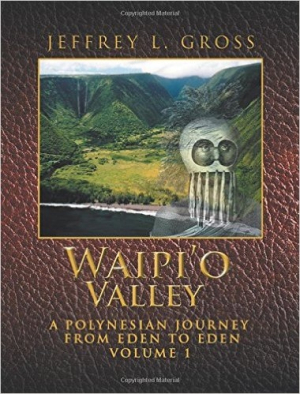Waipi'o Valley
Waipi’o Valley is a long work of Hawaiian history that entices readers toward the islands.
With their breathtaking beauty and fascinating cultural history, the Hawaiian islands capture the imaginations of tourists and residents alike—as happened with Jeffrey Gross, who, after living on the islands earlier in his life, wrote Waipi’o Valley, an exhaustive study that chronicles the migration of Polynesian voyagers to what is now called Hawaii, specifically their move to its lush Waipi’o Valley.
Located on the Big Island, Hawai’i, the Waipi’o Valley was a magnet for those voyagers. In the earliest Common Era centuries, they were attracted to its location, trading potential, cultivation opportunities, friendly temperatures, and to the valley’s mystical connections to revered deities.
Early chapters trace the time line of their migrations, as well as detailing the geology and geography of the Hawaiian islands. Subsequent chapters describe in great detail the Mesopotamian-based roots that shaped the voyagers’ worldviews, particularly the important impact that their beliefs and expectations made in a valley whose own legends, religious traditions, and rituals also intimately shaped their socio-political structure and cultural mythologies.
A stunning juxtaposition of images—the valley’s physical beauty and its strong cultural rituals— graces the book’s cover, offering an enticing portal. Many illustrations, most in color, of early maps, totemic figures, and native drawings are sprinkled throughout the book; they provide glimpses of what the valley and its first inhabitants looked like to enterprising voyagers.
Many subtopics––on early Hawaiian and early Mesopotamian cultural mythologies, Hawaiian royalty lineage, Tahitian history, Hawaiian topology, and island political intrigue—are covered in fine detail. Many seem to warrant whole books of their own, and sometimes risk diluting the book’s primary focus.
Gross’s utter fascination with Hawaii’s tangled mass of people, places, and events is apparent as he drills down to very esoteric facts in many categories. Such facts will fascinate some, but may also be distracting.
To experience all that is special about Waipi’o Valley, it may be preferable to savor the book a chapter at a time, allowing the myriad details to form a meaningful narrative that falls together in time. With no subheadings as visual resting points, this vast, single-spaced, and small print book is often hard on the eyes.
Coupled with its extensive bibliography, Waipi’o Valley is a long work of Hawaiian history that entices readers toward the islands.
Reviewed by
Patricia Kutza
Disclosure: This article is not an endorsement, but a review. The publisher of this book provided free copies of the book and paid a small fee to have their book reviewed by a professional reviewer. Foreword Reviews and Clarion Reviews make no guarantee that the publisher will receive a positive review. Foreword Magazine, Inc. is disclosing this in accordance with the Federal Trade Commission’s 16 CFR, Part 255.

